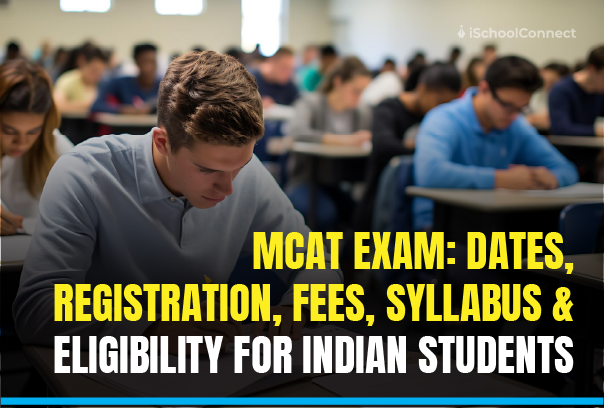Table of Contents
IELTS is an internationally renowned and recognized English Language Testing System designed for applicants wishing for a job or education abroad. The IELTS exam is a crucial prerequisite for applying to universities and organizations in countries where English is the primary language and mode of communication for study. It is specifically designed to evaluate a candidate’s proficiency in English. However, there is a key difference between IELTS Academic and IELTS General versions.
What is Academic IELTS?
- As the name conveys, Academic IELTS is an English proficiency test that assesses students’ reading, writing, and listening skills for academic environments at colleges and universities.
- It is a benchmark evaluation yardstick for students applying for overseas colleges and educational institutions.
- Applicants who wish to pursue an undergraduate or postgraduate course/discipline in a foreign university write these tests.
- Students can attempt Academic IELTS at a test center or remotely online.
- The test duration is 2 hours and 45 minutes.
- Apart from admissions to universities, Academic IELTS is also mainly used to obtain professional employment as a physician, nurse, teacher, or attorney.
What is General Training IELTS?
General Training IELTS basically means:
a. The IELTS general training test is used for non-academic purposes, such as applying for immigration visas or working in English-speaking countries.
b. The IELTS General Training test serves several essential purposes, primarily focused on practical English language proficiency in an everyday context.
C. This exam is a crucial requirement for visas and employment in many nations, ensuring that candidates are capable of interacting effectively in English in the workplace and social settings.
Training for IELTS Academic & IELTS General:
- IELTS Academic & General Listening Section
The listening section is identical in both the Training for IELTS Academic & IELTS General. It consists of four recorded sections with a total of 40 questions designed to assess the ability to understand spoken English in various contexts.
- IELTS Academic & General Reading Section
There is a notable difference between the two tests in the reading section. The Academic IELTS comprises three long readings from books, journals, and articles, focusing on complex subjects requiring high-level reading skills. Meanwhile, the General IELTS Reading section is divided into three sub-parts: the first two contain shorter texts related to everyday life and work, while the third includes a longer text of general interest.
- IELTS Academic & General Writing Section
The writing section also shows clear differences. In the Academic IELTS, candidates face two tasks: Task 1 involves describing visual data in a minimum of 150 words, and Task 2 requires writing an essay on an academic topic with a minimum of 250 words. On the other hand, in the General IELTS Writing section, Task 1 includes candidates writing a letter(formal or informal) in at least 150 words, and Task 2 includes writing an essay similar to the academic version but based on a general interest topic.
- IELTS Academic & General Speaking Section
The speaking section remains the same across both the Training for IELTS Academic & IELTS General versions, comprising three parts: an introduction and interview, a long turn where the candidate speaks about a given topic for 1-2 minutes. While the format is the same, content may vary.
Requirements for IELTS Academic
The IELTS Academic test is suitable for those who wish to study at undergraduate or postgraduate level or for professional registration purposes.
Here are the requirements for IELTS Academic:
IELTS Academic Listening
- 40 questions
- 4 sections: recordings of native English speakers
- Question types include multiple choice, matching, plan/map/diagram labeling, form completion, note completion, sentence completion, and short answers.
IELTS Academic Reading
- Three long texts ranging from descriptive and factual to argumentative and analytical.
- 40 questions
- Question types include multiple choice, identifying information (True/False/Not Given), identifying writer’s views/claims (Yes/No/Not Given), matching information, matching headings, matching features, matching sentence endings, sentence completion, summary completion, note completion, table completion, flow-chart completion, diagram label completion, and short answers.
IELTS Academic Writing
- 2 tasks
- Task 1: Write a report summarizing or describing the information in a graph, table, chart or diagram (150 words, 20 minutes)
- Task 2: Write an essay in response to a point of view, argument or problem (250 words, 40 minutes)
IELTS Academic Speaking
- 3 parts
- Part 1: Interview (4-5 minutes)
- Part 2: Individual long turn (3-4 minutes)
- Part 3: Two-way discussion (4-5 minutes)
Requirements for IELTS General
The IELTS General Training test is designed for individuals who plan to migrate to an English-speaking country, pursue non-academic training, or work in an English-speaking environment.
Here are the requirements for IELTS General:
IELTS General Listening
- Duration: 30 minutes (plus 10 minutes for transfer of answers)
- Content: 40 questions based on four recordings of native English speakers, including conversations and monologues.
IELTS General Reading
- Duration: 60 minutes
- Content: 40 questions divided into three sections:
- Section 1: 2-5 short texts (e.g., advertisements, notices)
- Section 2: 2 texts related to the workplace (e.g., safety regulations)
- Section 3: A longer instructional text of greater difficulty.
IELTS General Writing
- Duration: 60 minutes
- Content: 2 tasks
- Task 1: Write a letter (minimum 150 words) in response to a given situation.
- Task 2: Write an essay (minimum 250 words) expressing a viewpoint or argument.
IELTS General Speaking
- Duration: 11-14 minutes
- Content: A three-part interview with an examiner:
- Part 1: General questions about the candidate (4-5 minutes).
- Part 2: Individual long turn where the candidate speaks on a given topic for 1-2 minutes (3-4 minutes total).
- Part 3: Two-way discussion based on the topic from Part 2 (4-5 minutes).
Let’s summarize the key differences between Training for IELTS Academic & IELTS General in a tabular format:
| Aspect | IELTS Academic | IELTS General Training |
| Purpose | Design For those seeking higher education or professional registration. | Aimed at individuals seeking to migrate or work in an English-speaking country. |
| Content-Focus | Focuses on academic topics suitable for university or professional institutions. | Focuses on general interests and topics relevant to everyday life and work situations. |
| Reading-Section | Contains three long passages from academic texts like journals and articles. | Contains passages from brochures, advertisements, and everyday contexts. |
| Writing Task 1 | Involves describing visual information like charts and graphs. | Involves writing a letter based on a given situation(formal or informal). |
| Writing Task 2 | Involves writing an essay on an academic issue or argument. | Involves writing an essay on a statement or topic of general interest. |
| Listening and Speaking Sections | Identical format and content for both tests. | Identical format and content for both tests. |
Recommended reads:
To boost your IELTS preparation, get practice tests and sample IELTS papers with solutions. Click here.
Summary
For individuals pursuing higher education or professional registration, IELTS Academic is crucial as it assesses English proficiency for academic environments. Academic reading and writing assignments are its main focus. Conversely, IELTS General Training focuses on real-world, practical English and is intended for non-academic goals like immigration or employment in English-speaking nations. The reading and writing portions of both versions have substantially different content, even though they both have the same speaking and listening portions.






